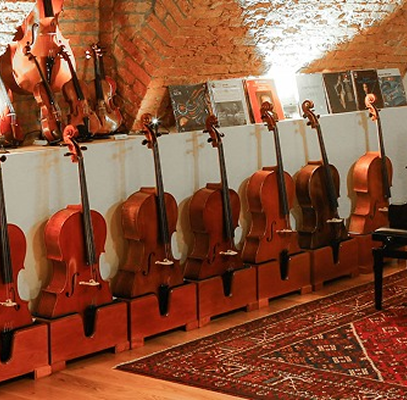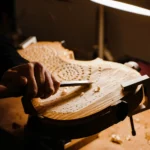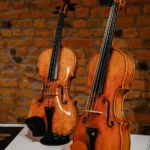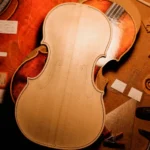From Stradivari to the Present Day: The World’s Greatest Violin Makers
Back to BlogFrom Stradivari to the Present Day: The World’s Greatest Violin Makers
Have you ever heard a solo violin performance so deep and moving that time seemed to freeze? Behind such enchanting sound lies not just the artistry of the violinist but the incomparable craftsmanship of a luthier—a wood-and-string animateur who brings music into being.
The history of violin making is as moving and abiding as the music itself. From the Italian masters of the golden age to the greatest violin makers of today who are defining today’s instruments, the legacy of renowned violin makers continues to live on in concert halls, collector showcases, and the hearts of musicians.
Through this odyssey through time, we meet the world’s greatest violin makers —both from the past and present—and see how their craftsmanship continues to influence generations of players and listeners alike.
The Golden Age: Cremona’s Legendary Luthiers
The epicenter of 16th to 18th-century violin crafting was, without a doubt, Cremona, Italy. Cremona was where a tradition of craftsmen crafted instruments so divine that to this day, they cannot be replicated. Here a list of the greates violin makers of the past:
1. Antonio Stradivari (1644–1737)
Perhaps the most renowned violin maker in history, Antonio Stradivari established the benchmark for craftsmanship and sound. His violins, called Stradivarius violins, are valued for their great projection, balance of tone, and beautiful visual detail. With more than 600 extant instruments, each is a testament to greatness, coveted by leading soloists and collectors alike. Stradivari’s violins have been played by greats such as Itzhak Perlman and Joshua Bell, and their sonic qualities continue to inspire rigorous acoustic studies to this day. The reverence surrounding a Stradivarius transcends time—it is more than an instrument; it is a voice of history.
2. Giuseppe Guarneri “del Gesù” (1698–1744)
Yet another Cremonese master, Guarneri “del Gesù”, produced violins with a richer, darker tone and more solid construction. A competitor to Stradivari in many minds, his violins possess a unique personality that appealed to great virtuosi such as Niccolò Paganini. Del Gesù’s instruments are bold and earthy, and thus perfectly suited for virtuoso performers who demand intensity and uniqueness.
3. Andrea Amati (c. 1505–c 1577)
The Cremonese school’s founding father, Andrea Amati, is attributed to have modeled the modern violin. His sons and grandson, Nicolò Amati, followed in his footsteps, later training Stradivari and Guarneri. The Amatis’ contribution to stringed instrument making set the stage for generations ahead.
The Forgotten Artists of Other European Traditions
Whereas Cremona was the pulse of violin crafting, other areas also gave birth to great talent.
1. Jacob Stainer (1617–1683)
An Austrian maker whose violins were popular prior to the Cremonese makers’ turn in the limelight. Stainer’s violins possess a high arch and sweet, warm tone, well-suited for Baroque repertoire. His work extended far across Europe, and his work was even praised by composers such as Bach.
2. Jean-Baptiste Vuillaume (1798–1875)
A 19th-century French mastermind, Vuillaume was an innovator as well as a master copyist. He made sublime copies of Stradivarius and Guarneri violins, some of which are almost impossible to tell from the authentic ones. He also made innovations in bow design and helped establish the Parisian school of luthiery.
Modern Masters: Tradition vs. Innovation
Today’s renowned violin makers are upholding traditional craftsmanship while adopting new innovations. The finest modern luthiers integrate tradition and creativity to build instruments that match the classics.
Luiz Amorim
Working in Cremona, Luiz Amorim is celebrated for combining old-world craftsmanship with a new-world aesthetic. His violins are characterized by their outstanding tonal palette, playability, and visual appeal. Up-and-coming soloists and established players alike rely on Amorim violins for instruments that are personal and expressive.
Amorim’s works honor profound respect for Cremonese tradition while breaking ground with subtle modern improvements in design and finish—a bridge between heritage and innovation.
What Makes a Violin Maker “Famous”?
Fame in the making of the violins alone is not something that happens overnight, but is the result of a refined aesthetic sense, decades of craftsmanship, and a commitment to continuous innovation. The greatest violin maker, or luthier, is recognized not just for how visually pleasing their instruments are, but for how those instruments play in the hands of maestros. A combination of these factors makes a violin maker one-of-a-kind.
Sound
At the core of any great instrument lies a tonal quality that impresses musicians and the audience alike. One of the world’s most celebrated violins, such as those crafted by Antonio Stradivari or Giuseppe Guarneri, is noted for its unmatched clarity and complex resonances. These instruments collaborate with the musician in creating powerful tunes that make them a favorite among prestigious soloists.
Legacy
Family heirlooms or pieces performed by legendary violinists contribute to their creators’ fame. Beyond sound, aesthetic details on the violins, including how the top plate arches, the precision of the purfling, and the depth of the varnish, all lend a unique touch to an instrument both visually and emotionally.
Innovations
In the modern age, famous violin makers, like Luiz Amorim, are all about innovation as they seek to combine classical methods with contemporary principles of acoustics. The renowned violin makers are driven to leave a lasting mark on the art and science of music by conjuring new techniques or approaches to music.
Recognition
Recognition by leading musicians, appearances at major performances, and inclusion in the finest collections. These elements collectively work to build a legacy that stands the test of time and wins the hearts of music lovers all over the world.
The Luthier’s Part in the Musician’s Odyssey
The perfect instrument can make a world of difference to a violinist. A well-crafted violin doesn’t simply emit sound—it feels more like an extension of the self that can simultaneously elevate emotion and respond to your natural rhythms. No wonder many musicians develop a lifelong rapport with their instruments. Luthiers, here, are not just regular craftsmen but true partners in memorable artistic creation. They are not only sustaining performance but legacy too, designing instruments to sing for centuries.
Selecting the Right Violin: Heritage or Contemporary Craft
There is no denying the worth of classics, but is it always the case that a 300-year-old violin is superior to one that is modern? No. The fact that quite many pro players are opting for contemporary makers such as Amorim, speaks volumes about their artistry and musical brilliance. These fiddles provide the advantage of near-perfect condition, tailored setup, and—most importantly—easier access than multi-million-dollar antiques. That said, antique violins are still unrivalled for their beauty and their financial worth for both connoisseurs of music and top soloists.
Where to Find Good Violins Today
Whether you’re an aspiring violinist or a seasoned performer, the key to the right instrument lies in a name you can trust. Amorim Fine Violins in Cremona boasts an exceptional collection of historic and modern violins, including the feature of custom additions to reflect a player’s unique style and needs.
Each instrument is more than a product—it’s a legacy waiting to be carried on by the next in line. The story of the violin is not just about music- It’s about art, soul, and the human desire to create beauty that lasts beyond lifetime. Be it Stradivari’s silent poetry in wood or Amorim’s living, breathing masterpieces, the world of famous violin makers continues to inspire awe and artistry.
To explore a violin that speaks your voice—past, present, or future—start your journey with the Amorim collection and indulge in the true essence of music.









